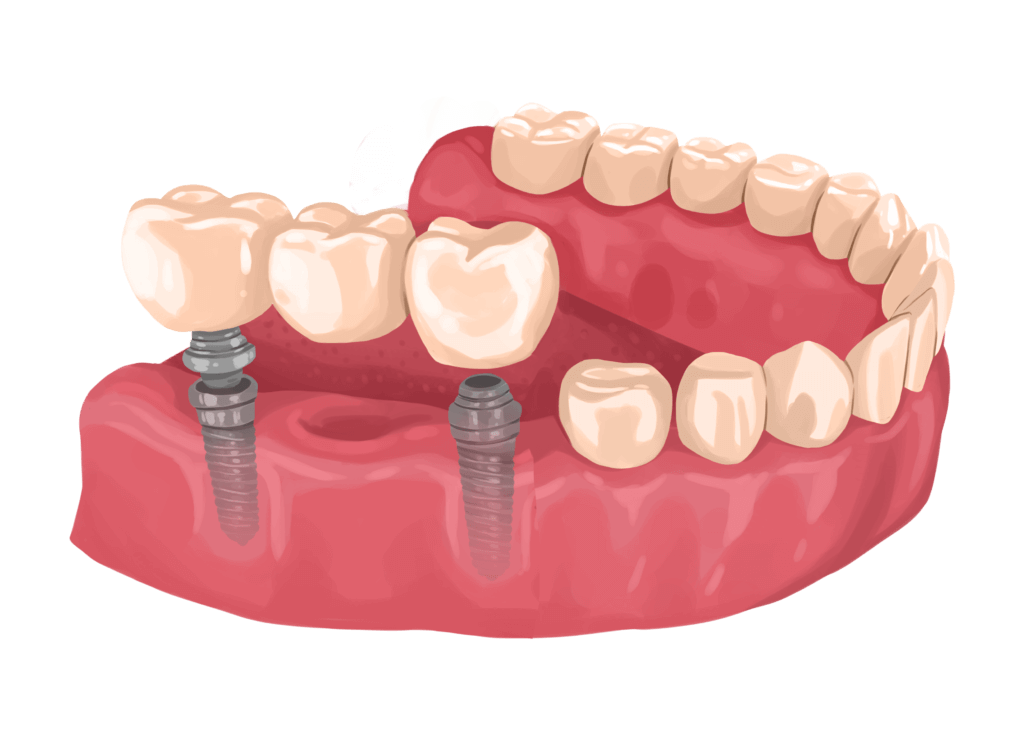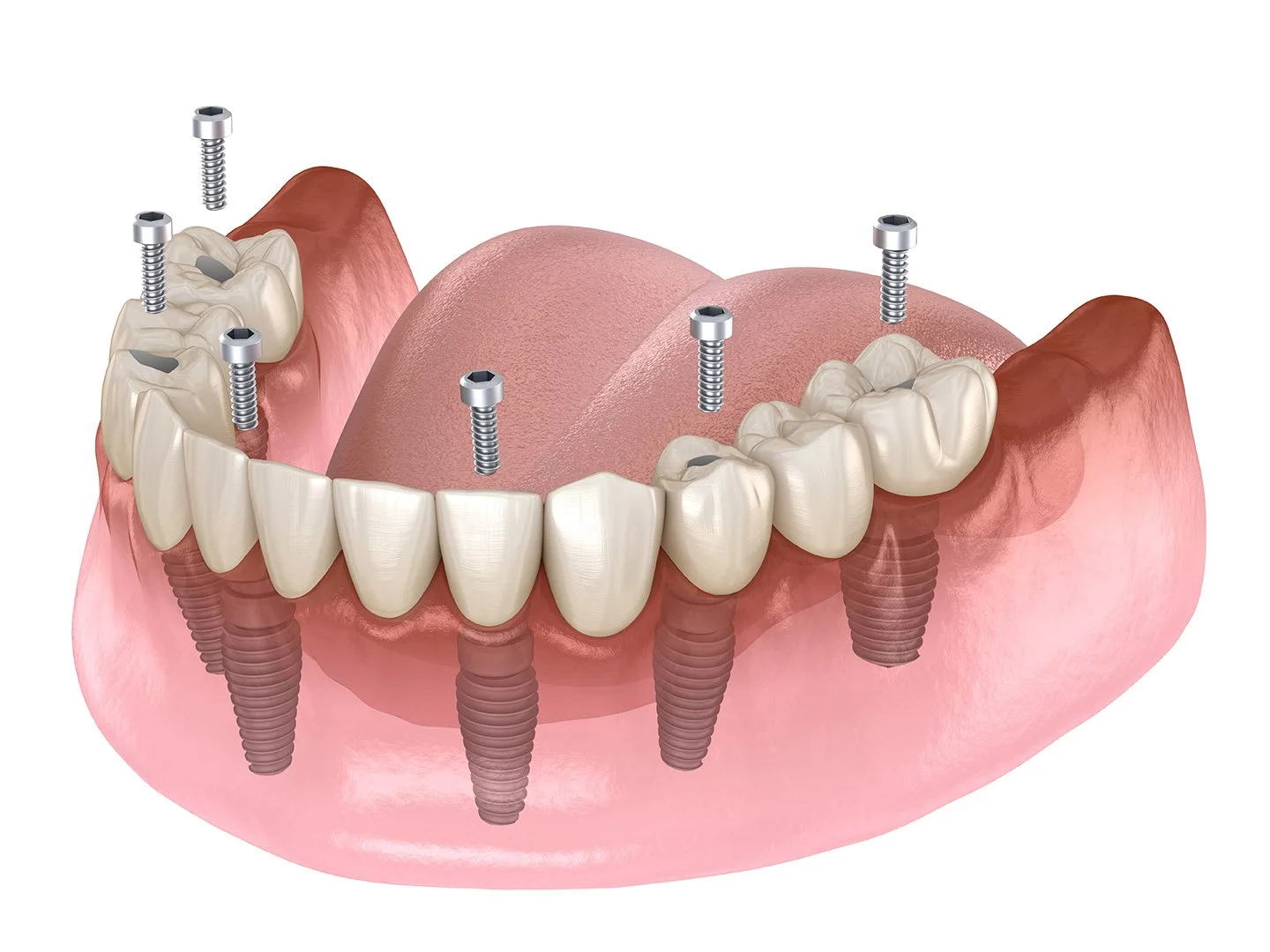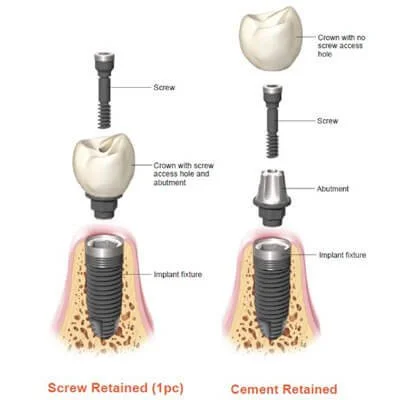What is a Dental Implant?
Dental implants are used to replace missing teeth in your mouth.
The implant itself is fixed into your jaw (replacing the root of your tooth), and a crown is made that can screw into the implant (replacing the actual tooth).
Implant prices vary depending on your mouth's situation and the dentist's skill level. A single tooth at the back can be from £2000-£3000, and a front tooth can be from £2500 - £5000.
If you have no teeth left, a whole row of implants costs around £10,000 - £15,000.
Why Choose a Dental Implant?
Implants are fixed into your mouth and don’t move, making eating, speaking, and kissing much more comfortable.
Dentures are often loose and uncomfortable and need to be removed when sleeping at night-time.
Bridges are also fixed into your mouth, but they are only advisable when the teeth next to the gap you are replacing have crowns already or would benefit from having a crown.
Different Types of Dental Implants
Single teeth
Single spaces are filled with 1 implant and 1 crown attached to that implant.
Costs: £2000+
Multiple teeth
Bigger gaps can be filled with multiple single implants, or with an implant-retained bridge.
Costs: £3000+
Full arches
Full arches are restored by using 2-6 implants and placing a long bridge on top of them. Read more
Costs: £10,000+
Different types of implant crowns
There are 2 main types of dental implant crowns, screw-retained crowns and cement-retained crowns.
Screw-retained dental implant crowns.
This type of implant crown sits in your dental implant and is held with a screw. These crowns can be easily removed and replaced, making it extremely easy to keep clean and check the implant's health at your regular check-up appointments. These crowns also very rarely come out of your mouth naturally.
Cement-retained dental implant crowns.
A cement-retained dental implant crown has 2 components, an abutment and the crown. The abutment is screwed into your implant, and the crown is seated using dental cement. These crowns are riskier as excess cement can stay around the margin of the crown and cause inflammation of the gums and bone around the implant. It is also harder to remove and replace cement-retained implant crowns.
The main benefit of cement-retained crowns is that there is no screw access hole in the crown, which improves the overall aesthetic of the crown.
Which type of crown is best for me?
You should almost always have a screw-retained dental implant crown. They are less likely to fail and are much easier to maintain in the long run than cement-retained crowns. The main reason you may have to go for a cement-retained crown is the angle of your implant doesn’t allow for a screw to be placed. For example, if the angle of your front implant is not ideal, then the screw hole for the crown will become visible.
If you are seeing a good implant surgeon/dentist, they will do everything they can to plan your treatment so that a screw-retained crown is possible.
The process of having a dental implant
Dental assessment
Your dentist will assess your mouth and teeth to develop the best treatment plan for you. This will involve checking:
Your oral and medical health
The health and volume of your bone in the implant area
The locations of your sinuses and nerves
Your dentist will need to take x-rays of the proposed implant area, and they may also need to take a cone beam scan (CBCT), a 3D x-ray. A good dentist will also take digital scans and pictures and assess the rest of your teeth as well to plan the best possible treatment,
Removing your teeth
If you are replacing a broken down or infected tooth, this tooth will need to be removed before placing the implant. A lot of the time, tooth removal and implant placement can be done simultaneously; however, depending on the quality of your bone, your dentist may want to delay your implant placement.
Bone grafting
If there is not enough bone in the area where the implant needs to go, your dentist may need to place a bone graft before placing the implant. This can be done with synthetic bone, animal bone or bone that is taken from elsewhere in your jaw.
Read more about bone grafting here.
Sinus lift
When placing implants in your upper jaw, if the floor of your sinus is too low, your dentist may need to lift the sinus floor to a higher position and place a bone graft to allow room for the implant.
Implant placement
Once the bone volume is sufficient, your dentist can place the implant into your jawbone. The implant will fuse with your bone over the next six months. Your dentist will provide a temporary denture/bridge/crown depending on the clinical situation for this period.
Making the final implant crown
Once the implant is fused with your bone and stable (3-6 months), you will be ready to make the final crown to sit on top of the implant.
For front teeth, it’s really important to get the shape of the crown right. The shape of the crown will determine what your gums will look like and how natural the implant will look. To get the best result, good dentists will use a temporary crown on the implant to shape the gum to the best possible position before making the final implant crown.
Looking after a dental implant
Implants are not a magical fix for your teeth. If you don’t look after them properly, they can fall out. Once you have had your implant fitted, you will need to take the following steps to maintain it:
Regular check-ups so that your dentist can:
Take x-rays and make sure the implant is healthy and the bone around the implant isn’t receding
Check your bite and make sure you're not biting on the implant too heavily
Check the implant is screwed in place tightly
Regular hygienist visits to clean around the implant
Daily brushing and interdental cleaning (flossing) around the implant
To make sure you keep your implants clean, you need to purchase some implant floss. This floss has a stiff end which allows you to push it through the gap between your teeth and use the thicker spongy end to clean around the implant head.
Chat with our dentists about implants
If you are interested in having a dental implant, then chat to one of our dentists for free here. We’ll be able to assess your teeth, give you more personalised information about what to expect from implant treatment and refer you to the best practices near you.
Recommended dentists for implant treatment
The following dental clinics have experienced implant dentists who can achieve good quality outcomes.
Innovadent Dental Clinic - London (E14) - A general dentist who carries out implant treatment, an affordable option with good results
Ten Dental - London (SW4 and SW12) - An advanced, modern clinic which achieves very high-quality results but will be more expensive
Advanced Dental Practice - London (SE1) - Implants placed by a consultant oral surgeon and restored by one of the well-trained general dentists, very high-quality outcomes but more expensive
Tunbridge Wells Dental Centre - Kent (TN4) - Family practice with a visiting professor who places the implants. The practice owner is also being trained in implant surgery.
Unsure about which clinic is right for you? Talk to one of our online dentists today by clicking here.


























Dental implants are revered as the best solution for replacing missing teeth for a multitude of reasons. But there’s one particular quality of an implant that brings about so many benefits for patients seeking to replace missing teeth.